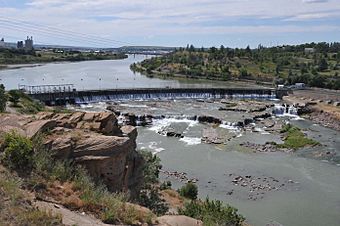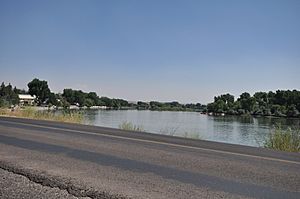Great Falls Portage facts for kids
|
Great Falls Portage
|
|

One of the (now dammed) falls bypassed by the portage
|
|
| Nearest city | Great Falls, Montana |
|---|---|
| Area | 7,700 acres (3,100 ha) |
| Built | 1805 |
| NRHP reference No. | 66000429 |
Quick facts for kids Significant dates |
|
| Added to NRHP | October 15, 1966 |
| Designated NHLD | May 23, 1966 |
The Great Falls Portage is a historic path used by the Lewis and Clark Expedition in 1805. They needed to carry their boats and supplies around the huge Great Falls of the Missouri River. This difficult journey is called a "portage."
The portage was about 18 miles (29 km) long and took the expedition 31 days to complete. Parts of this original route are now protected as a National Historic Landmark District. This special designation happened in 1966 to remember this amazing achievement. In 2008, the National Trust for Historic Preservation listed the site as one of America's Most Endangered Places. This means it is a very important historical site that needs protection.
Contents
The Lewis and Clark Journey
The Lewis and Clark Expedition was a famous journey across America from 1804 to 1806. It was the first big trip by English-speaking explorers into the northwestern plains. As they traveled up the Missouri River, the group reached the Great Falls area on July 13, 1805.
Discovering the Great Falls
The explorers had heard about the falls from the Hidatsa people. They had spent the winter with the Hidatsa. An advance team, led by Meriwether Lewis, went ahead to explore the falls. At that time, the falls were a long series of rushing waterfalls. They stretched far beyond where the city of Great Falls is today.
Many of these waterfalls have since been dammed. This was done to create hydroelectric power, which is electricity from water. Some parts of the falls are now surrounded by the city.
The Portage Route
The route chosen by William Clark started with a climb of over 1 mile (1.6 km). This climb was up a place now called Belt Creek. It is about 1 mile below the modern-day Morony Dam. From there, the expedition had to carry their boats. They used simple wagons they built themselves. They moved overland to a spot near the White Bear Islands. This area is south of the modern city.
The expedition's largest boat, a pirogue, was left behind at Belt Creek. The team celebrated Independence Day at their upper camp. They then continued their journey upstream on July 15. They had built two new canoes to replace the large boat they left behind.
Important Landmarked Areas
Two special parts of the portage route are now part of the National Historic Landmark District. This district was created in 1966.
Lower Portage Area
At the lower end of the portage, there is an area on the east bank of the river. This is where the expedition set up their camp. This spot is included in the landmarked area. The portage route up Belt Creek is also included. It continues for about 8 miles (13 km) across what are mostly farms today.
Sulphur Spring is also in this section. It is located above the west bank of the river, across from Belt Creek. The water from this spring was thought to have healing powers. It was used to treat Sacagawea, who had become very sick at the camp. This entire area is privately owned. It can be hard to reach by land.
Upper Portage Area
The other important part of the portage that is landmarked is the last 2.5 miles (4.0 km) of the route. This section goes from Mount Olivet Cemetery to the White Bear Islands area. When the expedition was there, there were three White Bear Islands. One of them has since joined the western shore because of silt. The actual camp site was probably a bit east of the current eastern bank. The land in this area is also privately owned. However, public roads cross through it.




